If you’ve never tried pickled daikon, you’re in for a treat! This easy recipe is one of my go-to side dishes—sweet, tangy, and ready in just one day with barely any prep.
I always keep a jar in the fridge to toss into honey sesame chicken bowls, salmon rice bowls, or even a quick stir fry. It adds the perfect zing and my kids love it!
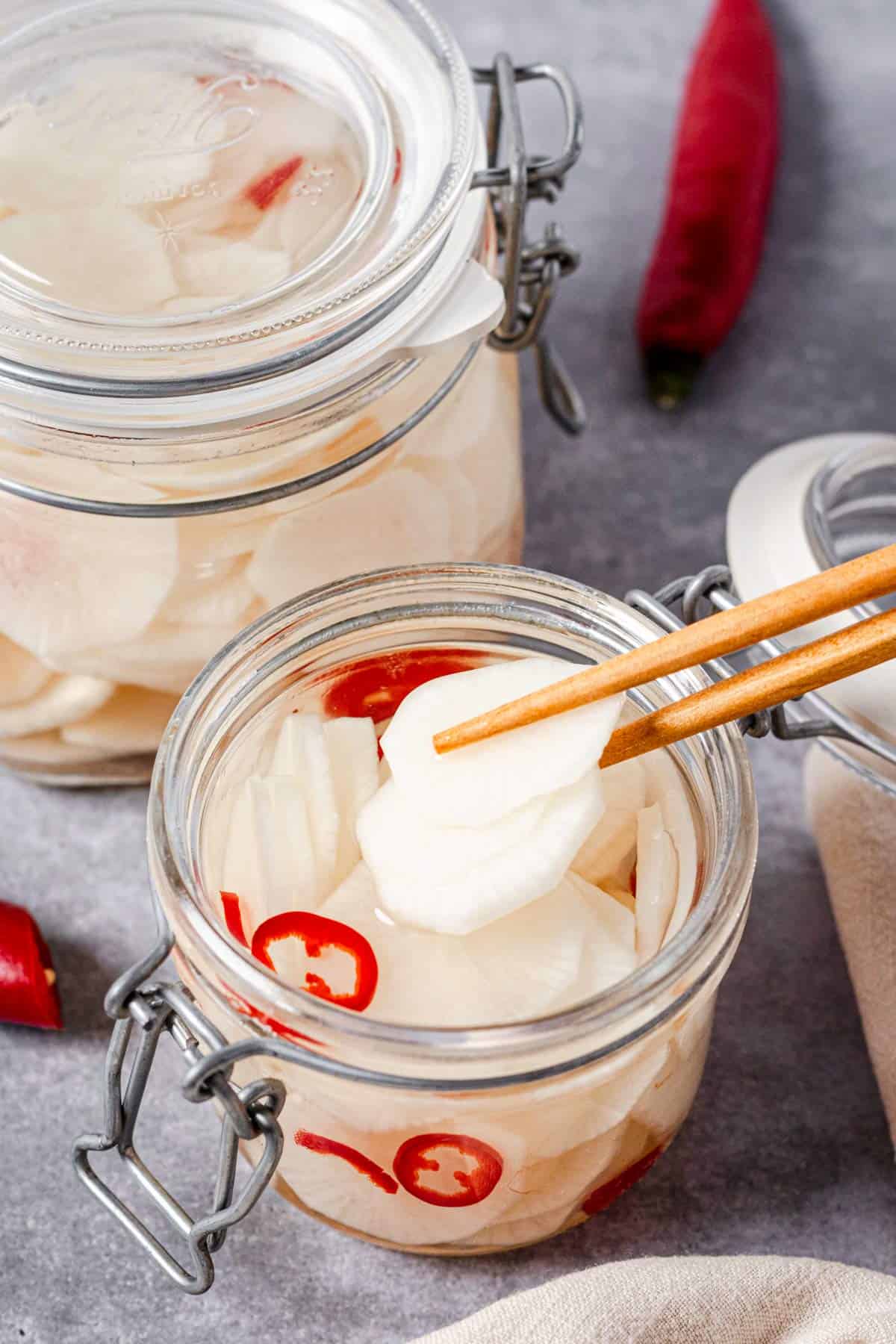
If you love radish recipes, be sure to check out my cucumber salad and roasted potato salad.
Pickled Daikon Radish Recipe Ingredients
- Daikon radishes - Japanese food and it means ‘’big root’’, white turnip, white radish, or simply radish (or some even call it white carrot) is a long white root vegetable with a mild flavor. It is also called a winter radish and it has an elongated shape and comes in different sizes.
- Vinegar - For the vinegar solution, we used rice wine vinegar. Although white wine vinegar or apple cider vinegar can be easily substituted, I prefer using rice wine vinegar for the best result.
- Red chili pepper - Or red pepper flakes—are optional add-ons that, in my opinion, complete this dish. If you prefer a less spicy option, leave it out completely.
📋 You can find the full ingredient list in the Recipe Card below the article.
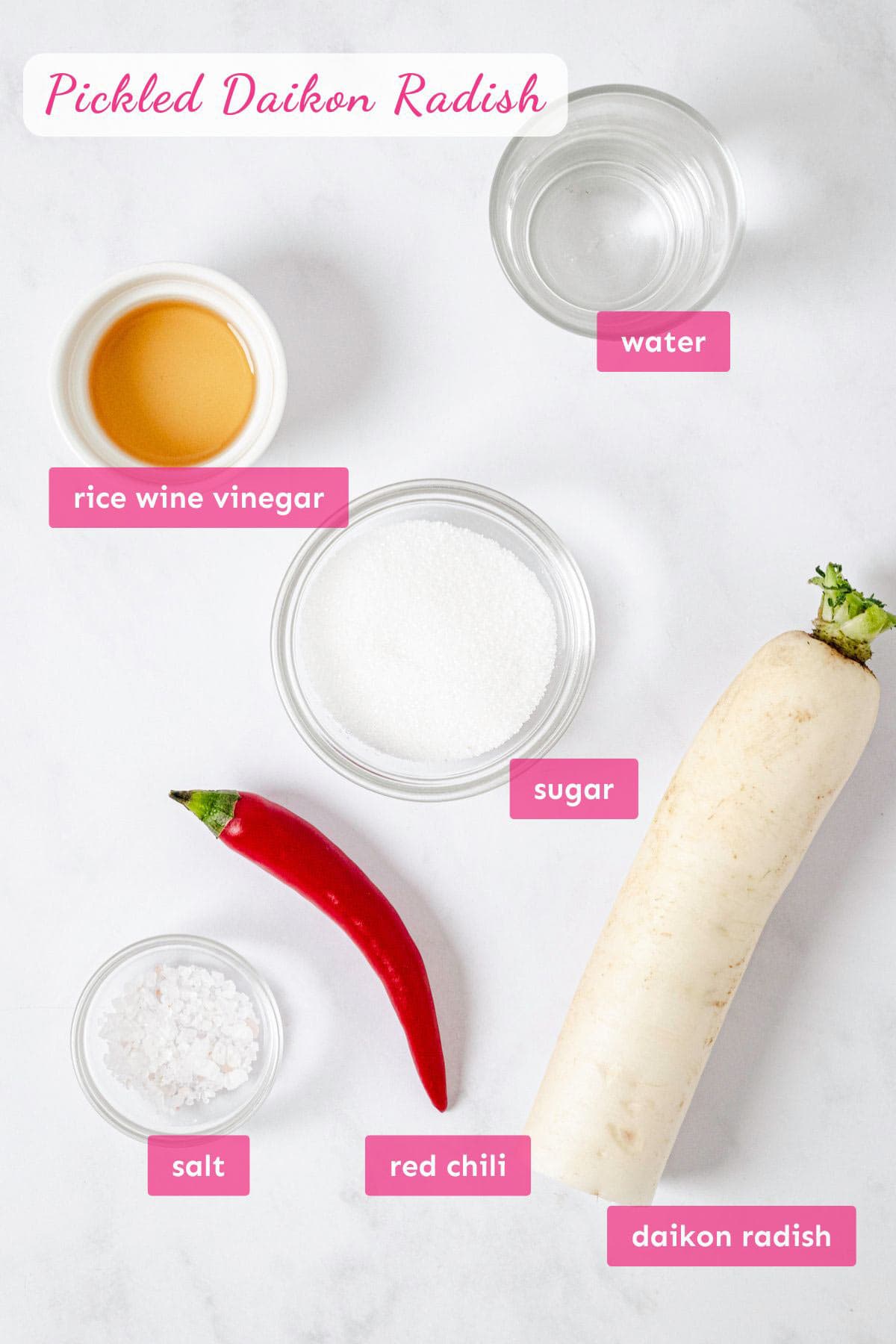
Want to Save This Recipe?
Enter your email and we’ll send the recipe directly to you!
By submitting this form, you consent to receive emails from The Yummy Bowl.
Recommended Tools
- Jars - If you don't have jars, you can use two medium-sized or one large mason jar or a good old glass airtight container.
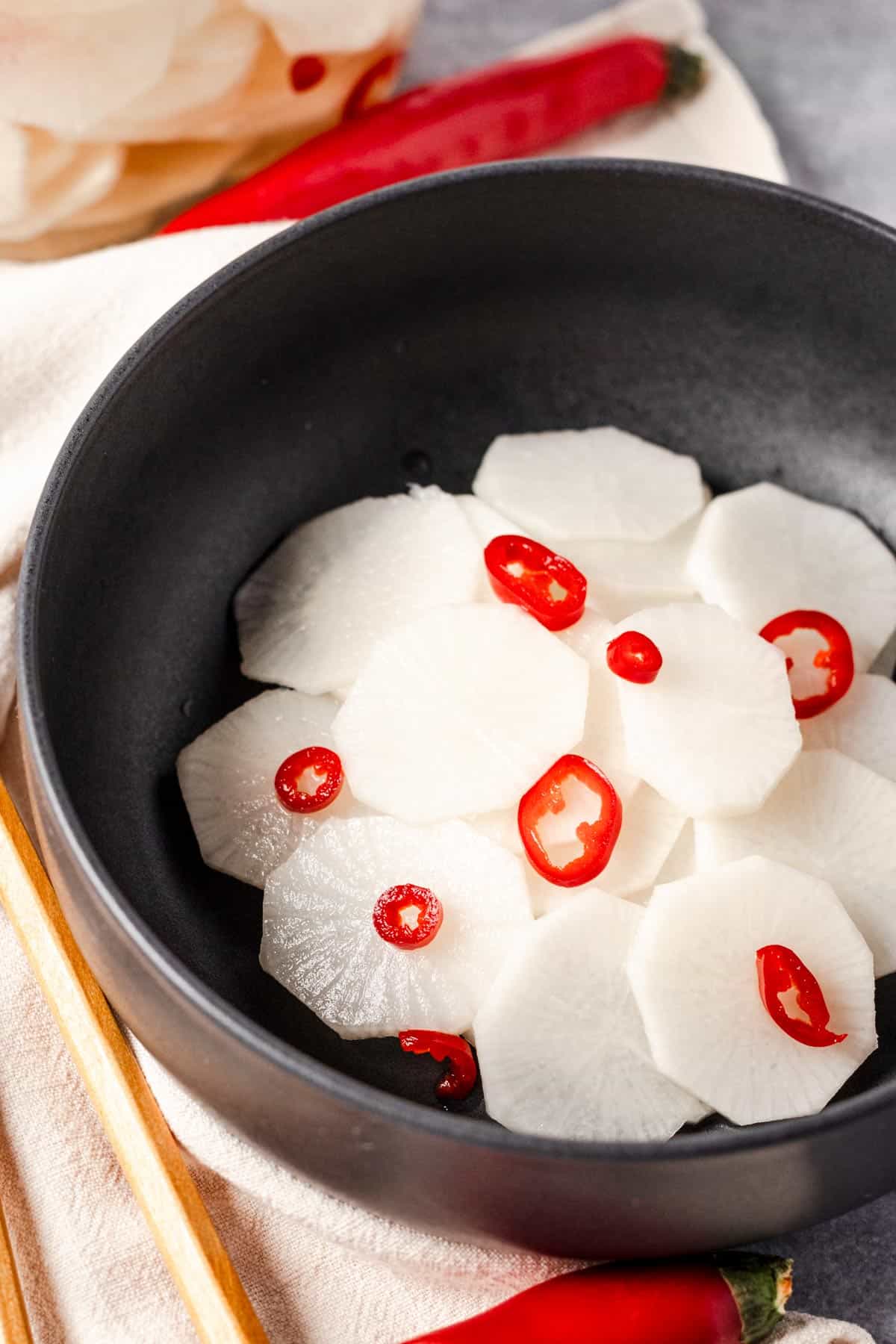
How To Choose Daikon
Daikon is a long white radish with a crunchy texture and a little peppery taste.
It is widely used in Vietnamese, Japanese and Korean BBQ and cuisine.
- Like most root veggies, choose daikon with fresh green leaves, not wilted, brown, or yellow leaves.
- It should be plump, more or less straight, and heavy.
- Shiny and bright white color and overall fresh looking.
- Pores are fine, but the fewer the better. Daikon should be smooth and firm to the touch.
Tips for the Best Pickled Daikon Radish Recipe
- If you don’t have a mandolin slicer, a good wide chef’s knife is the best tool for cutting veggies thin.
- Pop in some fresh cilantro for extra flavor.
- Don’t toss the green leaves away! They are highly nutritious and, when cooked, can be added to various dishes like miso soups, ramen, and woks.
Julia's Tip
You don’t necessarily need to cut the daikon in coins, especially if you using large daikon radish.
Matchsticks, julienne work just fine. Also, a good vegetable peeler will slice the daikon into thin and long slices.
How To Make Pickled Daikon Radish
I used two medium jars or you can use 1 large 32-ounce jar here.
The jars need to have wide openings so you can easily pull out the veggies when needed.
- Peel the daikon radish and slice it very thinly, about ⅛ inches thick. A mandoline slicer works perfectly here.
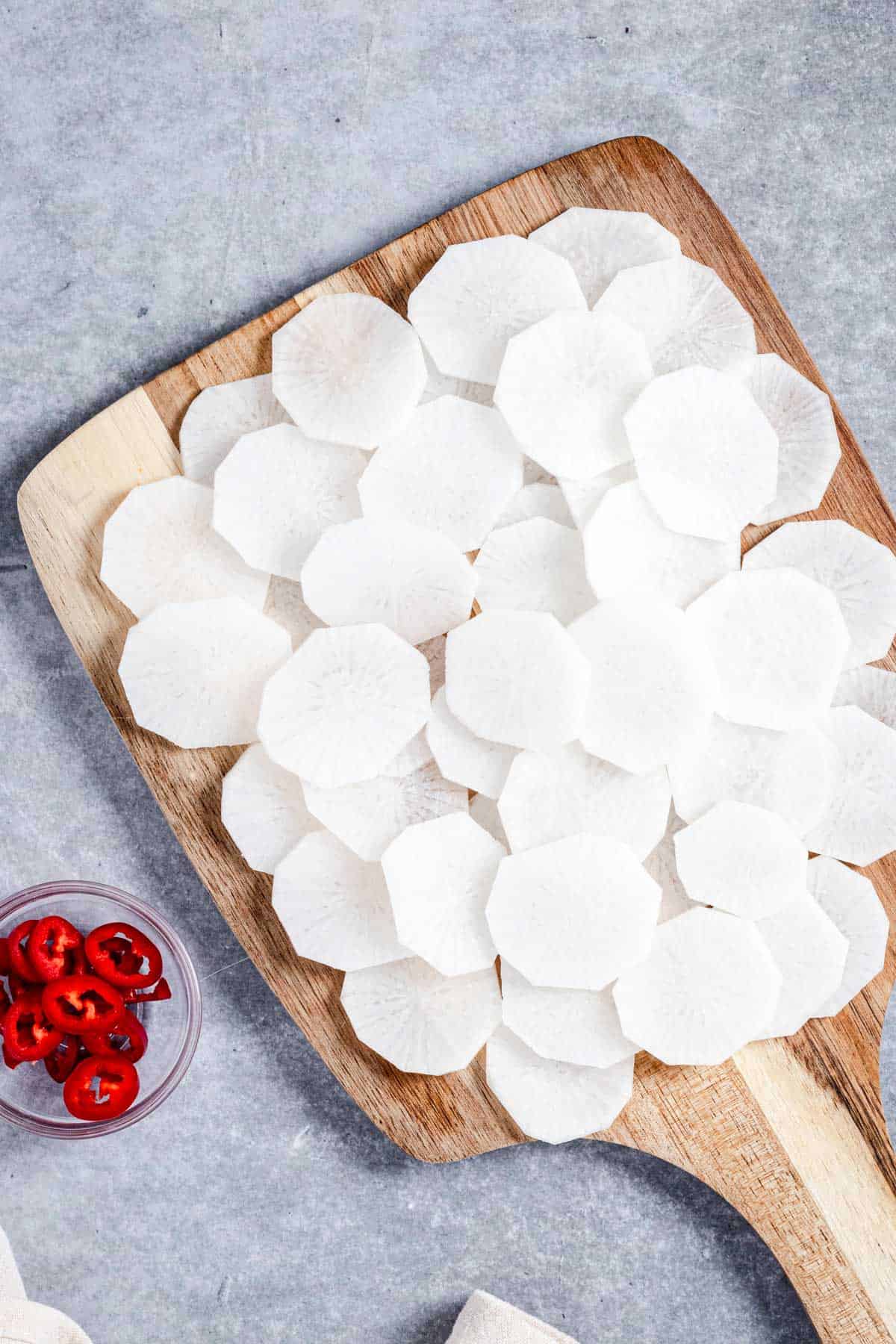
- Combine water, sugar, and salt in a small saucepan over medium heat, using non-reactive materials (use ceramics, enamel, glass, plastic, or stainless steel).
- Stir until sugar and salt are dissolved.
- Bring this mixture to a gentle boil. And pour in the vinegar.
- Bring to a boil, again and set aside.
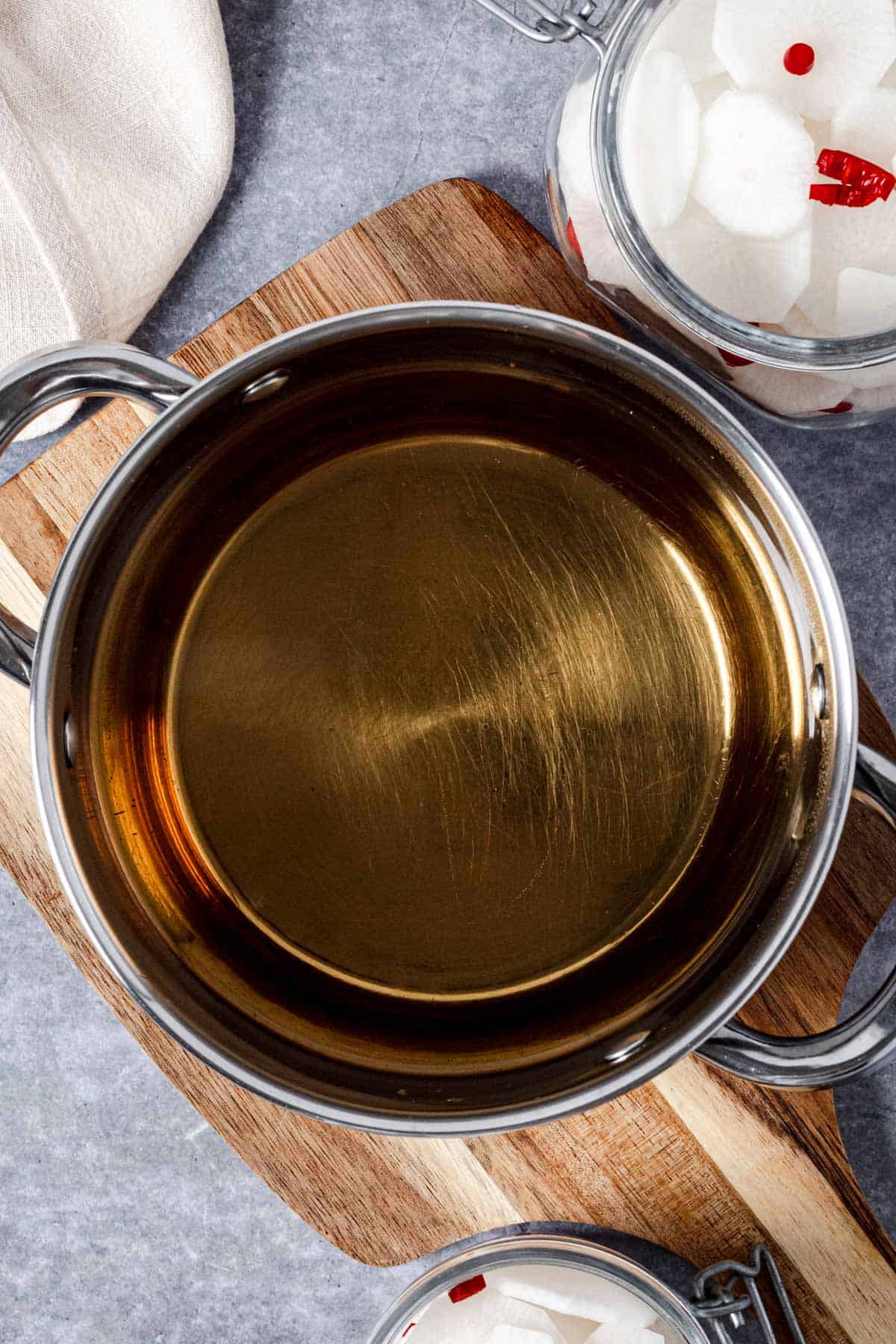
- In your jars, combine daikon and thinly sliced red chili.
- Pour the hot pickling solution mixture until the daikon is fully submerged in the pickling liquid.
- Secure the lid and let the mixture cool at room temperature for 1 hour. After that, refrigerate for 12 hours (overnight).
I would ideally wait for 1-2 days for the daikon to "fully pickle," but you can eat it once it is cold.
Pickled Daikon's crunchy texture is a delicious accompaniment to various Korean and Japanese dishes, including soups, noodles, sandwiches, and many more.
Store in the refrigerator for up to 2-3 weeks. However, I recommend consuming this within 2 weeks.
After 2 weeks, it is still edible, but the daikon will lose its crisp texture and fresh flavor and become soft.
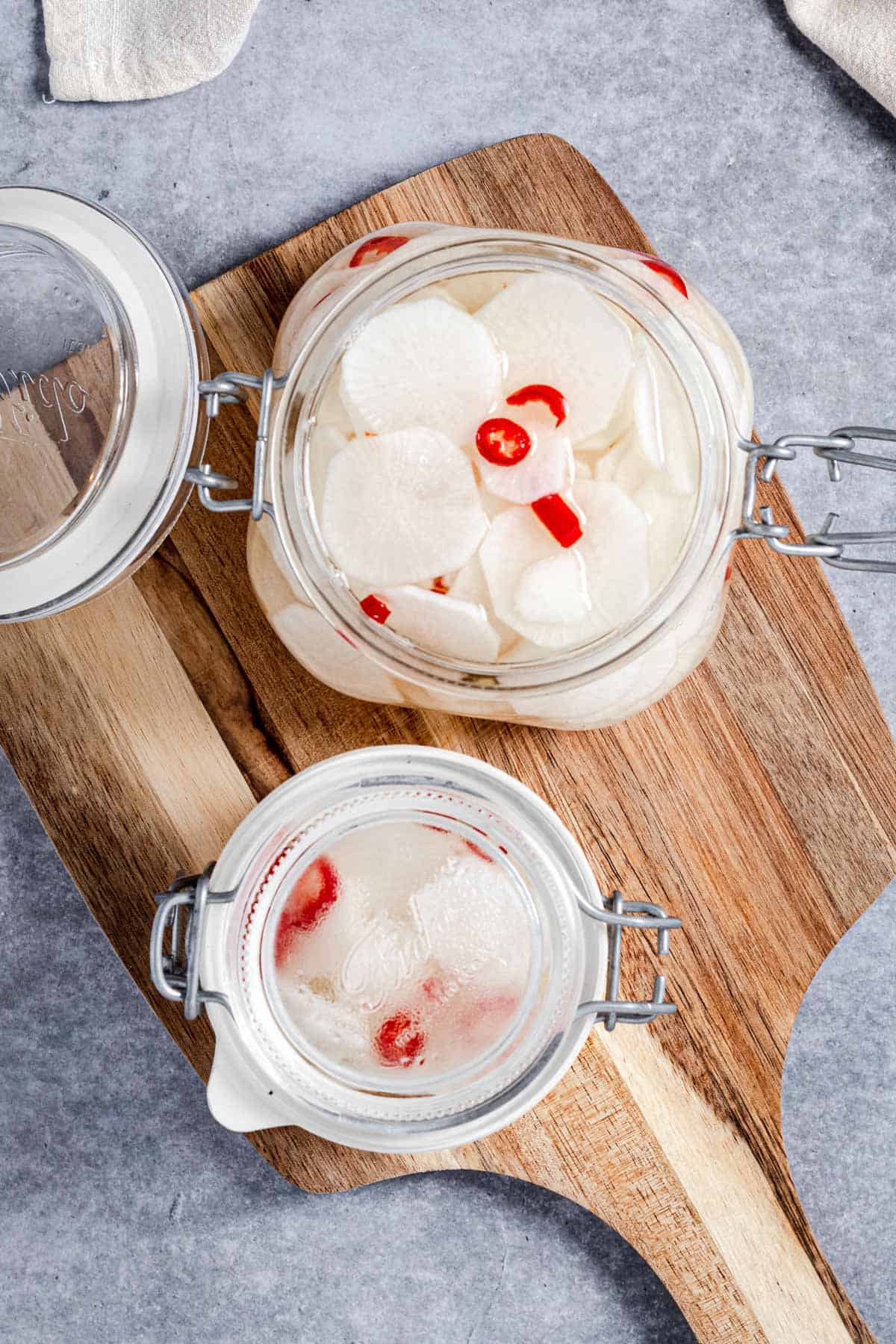
How To Use Pickled Daikon in Recipes
It has savory, tart, and sweet flavors all in one! Serve it with your favorite Japanese meals, fatty meats, or seafood dishes.
I love to serve it with:
- Tuna or shrimp tacos.
- Julienne the slices and add into soba noodles, or other similar like Yakisoba dishes, or spicy miso ramen.
- Sweet and sour chicken
- Miso salmon
- Pad Kra Pao
- As a topping for Yachaejeon and cabbage pancakes
- Honey garlic chicken
- Crispy tofu
- Cabbage stir rry
- Lo mein
How To Store Pickled Daikon Radish
- This recipe is for quick pickles, which will generally last about 2-3 weeks (food safety-wise).
- For the best flavor consume within 2 weeks.
- After 2 weeks, it is still edible, but pickled daikon will lose its crisp texture and fresh flavor and become softened. If the liquid becomes discolored or dark, it’s not good anymore.
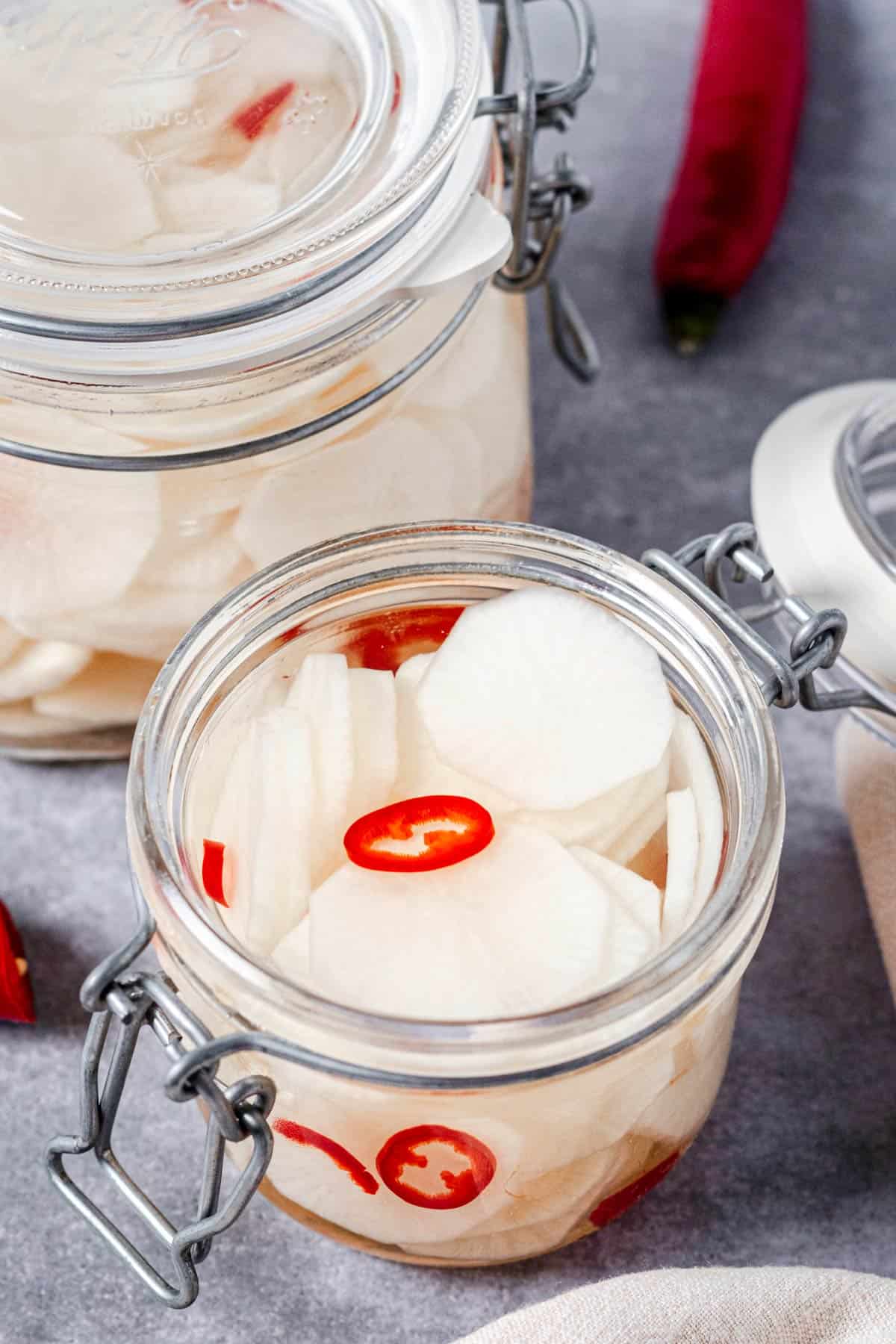
🧑🍳 Check out also: 20+ Best Daikon Radish Recipes
Did You Like This Recipe?
Leave a ⭐️⭐️⭐️⭐️⭐️ rating below and share it on Instagram, Facebook, and Pinterest!
Recipe Card
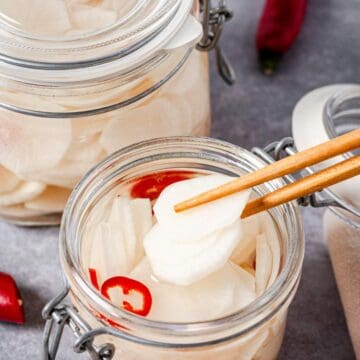
Quick 3 Ingredient Pickled Daikon Radish
VIDEO
Want to Save This Recipe?
Enter your email and we’ll send the recipe directly to you!
By submitting this form, you consent to receive emails from The Yummy Bowl.
INGREDIENTS
- 1 pound fresh daikon
- 1 cup rice wine vinegar, rice vinegar
- 1 cup spring water
- 1 cup white sugar, granulated white sugar
- 1 teaspoon of salt, coarse sea salt or regular is fine too
- 1 tablespoon red chili pepper, thinly sliced, is optional!
INSTRUCTIONS
- I used two jars or you can use 1 large 27 ounce jar here.
- Peel the daikon radish and slice it very thinly. About ⅛ inch thick. Mandolin slicer works perfectly here.
- In a non-reactive (use ceramics, enamel, glass, plastic, or stainless steel) small saucepan over medium heat combine together water, sugar, and salt. Stir until sugar and salt dissolve. Bring this to a gentle boil. And pour in the vinegar. Bring to a boil, again and set aside.
- In your jars, combine daikon and thinly sliced red chili.
- Pour in the hot pickling solution mixture until the daikon is fully submerged in the pickling liquid.
- Secure the lid and let the mixture cool at room temperature for 1 hour. After that, refrigerate for 12 hours (overnight) and enjoy. For the daikon to ‘’fully pickle’’ I would wait for 1-2 days but you can eat them once they are cold. Pickled Daikon crunchy texture is a delicious accompaniment to various Korean, Japanese dishes, including soups, noodles, sandwiches and many more.
- Store in the refrigerator for up to 2-3 weeks. However I recommend to consume this within 2 weeks. After 2 weeks it is stil legible but daikon will loose it’s crisp texture, fresh flavor and become softened.
NOTES
- Makes about 8-10 servings.
- I used two medium jars or you can use 1 large 32-ounce jar here. The jars need to be with wide openings so that you can easily pull out the veggies when needed.
- This recipe is for quick pickles, which will generally last (food safety-wise) about 2-3 weeks.
- But for the best flavor consume within 2 weeks. After 2 weeks it is still edible but pickled daikon will lose its crisp texture, and fresh flavor and become softened.
- You’ll see if the liquid gets discolored or gets dark it’s not good anymore.
- You don’t necessarily need to cut the daikon in coins, especially if you using large daikon radish. Matchsticks, julienne work just fine. Also, a good vegetable peeler will slice the daikon into thin and long slices.
- Don’t toss the green leaves away! They are highly nutritious and when cooked can be added to various dishes like miso soups, ramen, and woks.
- Chili - makes the daikon mildly spicy, if you like add more or leave it out completely for more pure daikon flavor.
ADD YOUR OWN PRIVATE NOTES
NUTRITION
Note: Nutrition information is estimated and varies based on the products used.
Full Nutrition Disclaimer can be found here.
Daikon Radish: FAQs
Quick-pickled daikon radish will typically last (food safety-wise) about 2-3 weeks. For the best flavor, consume within 2 weeks.
Its tart and sweet flavor complements not only Japanese meals, will also go well with a variety of dishes like fatty meats, stir fries, rice bowls, meatballs.
Check the blog post section above for a list of my favorite recommendations.
Daikon is radish. However, in certain regions of China, daikon radishes are called turnips.
In South Asian countries, daikon is often called "mooli." Due to its ability to withstand cold temperatures, it is sometimes referred to as winter radishes.
This daikon radish guide explains the differences.
First, check visually. If the brine appears excessively cloudy, it may signal spoilage or microbial activity.
Look out for slimy textures or drastic color changes, which are also signs of spoiled pickled radishes and the presence of mold.
You'll Also Love



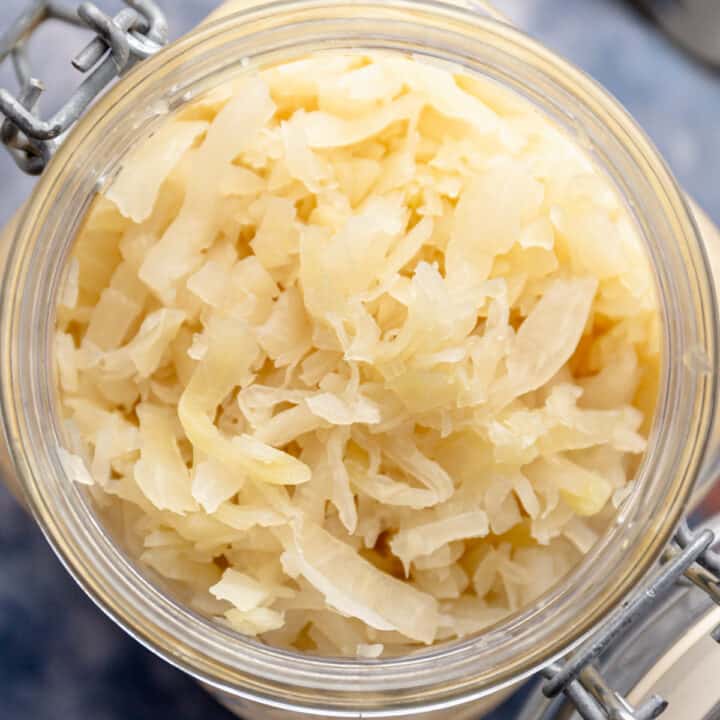
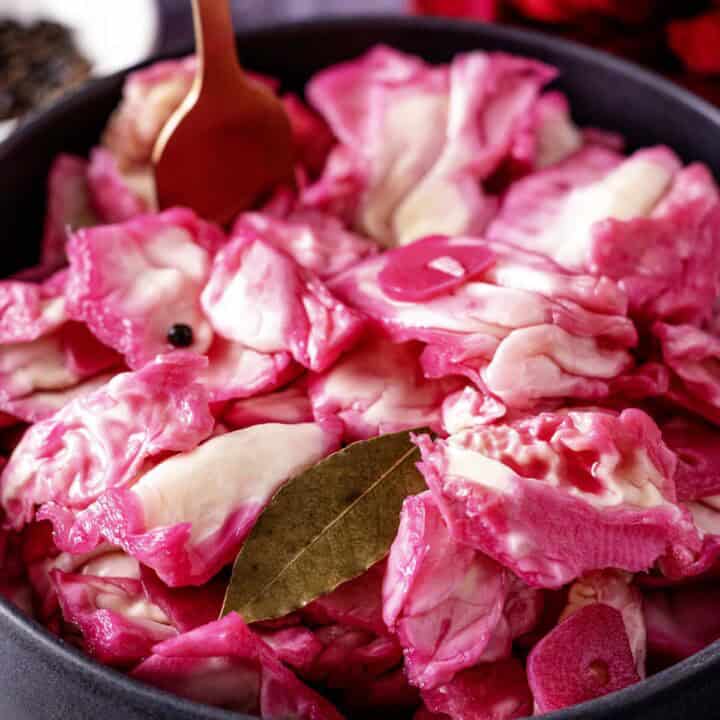
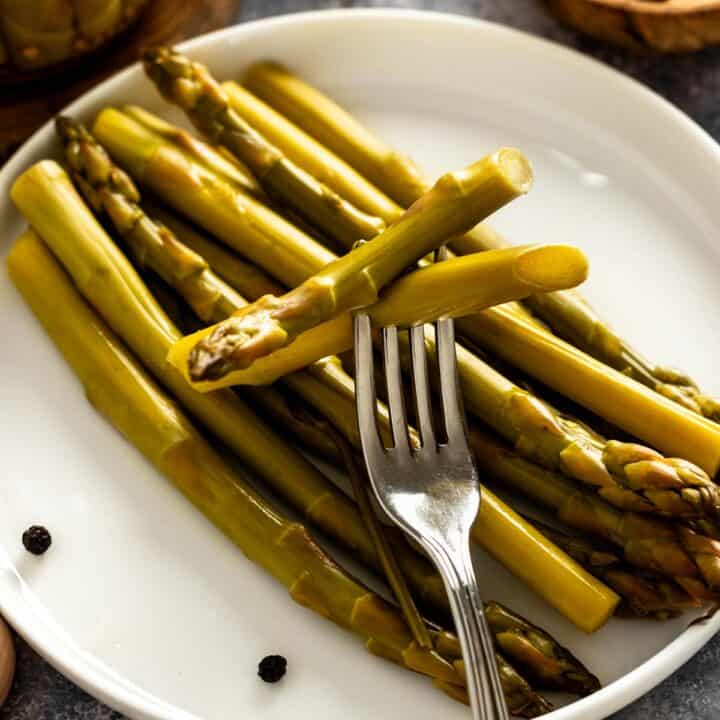
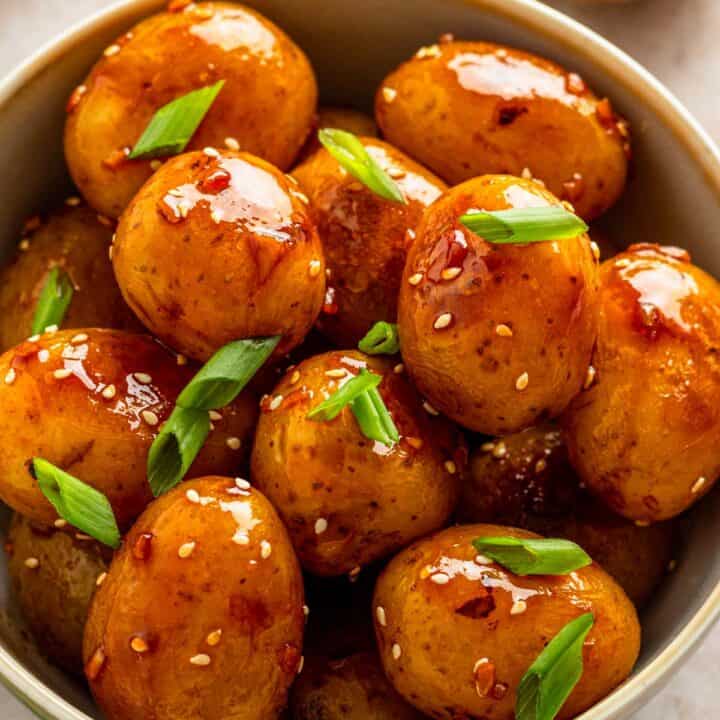
Ardelle Williams
Can radishes be frozen
As the amount pickled will not be used in 2-3 weeks
Julia
I wouldn't recommend it, try to consume it within these weeks, it is not a lot to add to dinner bowls.
Ardelle Williams
Ca
krasen
The sugar seemed too much for me and I made it using only half.
It was plenty sweet, Also I did not boil the solution as all of it was eaten in 2 days.
Eddy Robinson
Not legible... edible.
🙂
Emily
can you put those in Gin Martini?
Kaitlyn V.
I'm always on the lookout for unique side dishes and this pickled daikon radish recipe is just perfect. Planning to feature it in my next blog post with a couple of personal tweaks. Thank you, Julia, for the inspiration!
Trevor K.
Seems like a straightforward recipe. Might give it a try if I find myself with some extra daikon.